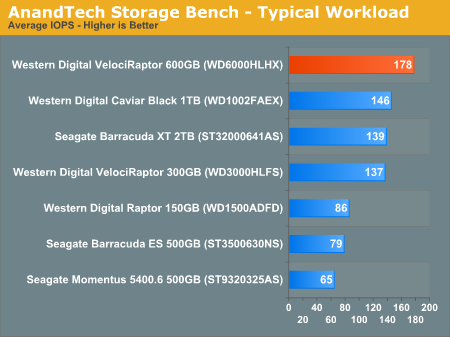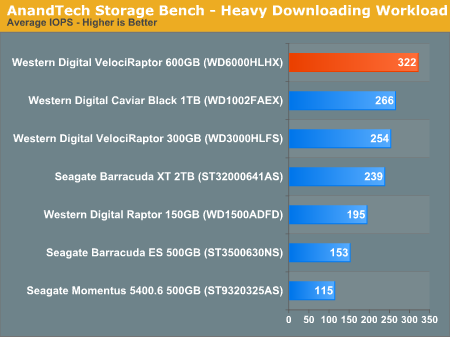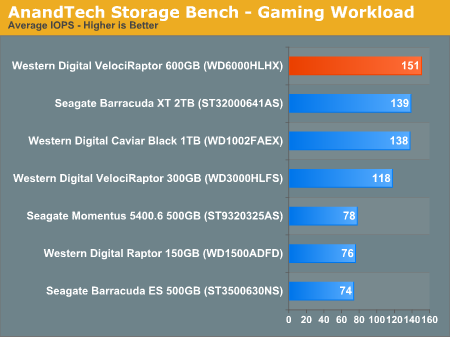Western Digital's New VelociRaptor VR200M: 10K RPM at 450GB and 600GB
by Anand Lal Shimpi on April 6, 2010 8:00 AM EST- Posted in
- Storage
AnandTech Storage Bench
The first in our benchmark suite is a light usage case. The Windows 7 system is loaded with Firefox, Office 2007 and Adobe Reader among other applications. With Firefox we browse web pages like Facebook, AnandTech, Digg and other sites. Outlook is also running and we use it to check emails, create and send a message with a PDF attachment. Adobe Reader is used to view some PDFs. Excel 2007 is used to create a spreadsheet, graphs and save the document. The same goes for Word 2007. We open and step through a presentation in PowerPoint 2007 received as an email attachment before saving it to the desktop. Finally we watch a bit of a Firefly episode in Windows Media Player 11.
There’s some level of multitasking going on here but it’s not unreasonable by any means. Generally the application tasks proceed linearly, with the exception of things like web browsing which may happen in between one of the other tasks.
The recording is played back on all of our drives here today. Remember that we’re isolating disk performance, all we’re doing is playing back every single disk access that happened in that ~5 minute period of usage. The light workload is composed of 37,501 reads and 20,268 writes. Over 30% of the IOs are 4KB, 11% are 16KB, 22% are 32KB and approximately 13% are 64KB in size. Less than 30% of the operations are absolutely sequential in nature. Average queue depth is 6.09 IOs.
The performance results are reported in average I/O Operations per Second (IOPS):

Performance in our real world benchmark however makes it very clear that no other hard drive is as fast as the 600GB VelociRaptor. WD delivers a nearly 30% improvement over the old drive, and 22% better performance than the new Caviar Black series.
If there’s a light usage case there’s bound to be a heavy one. In this test we have Microsoft Security Essentials running in the background with real time virus scanning enabled. We also perform a quick scan in the middle of the test. Firefox, Outlook, Excel, Word and Powerpoint are all used the same as they were in the light test. We add Photoshop CS4 to the mix, opening a bunch of 12MP images, editing them, then saving them as highly compressed JPGs for web publishing. Windows 7’s picture viewer is used to view a bunch of pictures on the hard drive. We use 7-zip to create and extract .7z archives. Downloading is also prominently featured in our heavy test; we download large files from the Internet during portions of the benchmark, as well as use uTorrent to grab a couple of torrents. Some of the applications in use are installed during the benchmark, Windows updates are also installed. Towards the end of the test we launch World of Warcraft, play for a few minutes, then delete the folder. This test also takes into account all of the disk accesses that happen while the OS is booting.
The benchmark is 22 minutes long and it consists of 128,895 read operations and 72,411 write operations. Roughly 44% of all IOs were sequential. Approximately 30% of all accesses were 4KB in size, 12% were 16KB in size, 14% were 32KB and 20% were 64KB. Average queue depth was 3.59.

Upping the number of writes doesn't change anything, the new VR is 26% faster than the old one and 21% faster than the best 7200 RPM drives. Keep in mind this is pure I/O performance, the real world performance is most likely in the 3 - 10% range on average which is what we saw in PCMark Vantage and SYSMark 2007.
The gaming workload is made up of 75,206 read operations and only 4,592 write operations. Only 20% of the accesses are 4KB in size, nearly 40% are 64KB and 20% are 32KB. A whopping 69% of the IOs are sequential, meaning this is predominantly a sequential read benchmark. The average queue depth is 7.76 IOs.

Sequential read performance is solid on the new VR, but not that much better than other, larger (and cheaper) drives on the market. Western Digital's advantage over the old VR is a healthy 27%, but over newer 7200 RPM drives it's barely 9%.










77 Comments
View All Comments
pjconoso - Tuesday, April 6, 2010 - link
The heatsink is quite massive for such a small hard drive. How hot do these things run? The price is very tempting considering that SSDs are VEEERRYY expensive here in our country (Philippines) but if I'm coming from the regulard Caviar Black and considered something like this, would it be worth it?Goty - Tuesday, April 6, 2010 - link
It's not that the drive runs hot, it's that it's a 2.5" unit and therefore doesn't fit well in most desktop cases. I can't remember where, but I remember some tests that were done not too long ago comparing temps with and without the heatsink and there was little difference.nurd - Tuesday, April 6, 2010 - link
Just so. If you actually hold them (well, the 300's at least, and I'm assuming these aren't much different), you'll note that there really isn't a lot of tight contact area for heat to be sunk into it. It's just a carrier; the "heatsink" look is cosmetic.pjconoso - Tuesday, April 6, 2010 - link
In my opinion, they should've opted for the cheap bracket support for mounting this thing as a 3.5-inch hard drive rather than upping the cost because of the heatsink - that would've brought the prices down a bit, don't you think?HillBeast - Wednesday, April 7, 2010 - link
The thing is though, this drive is designed to be in servers and the like and is designed to handle 24/7 operation so if they just opted for a cheap bracket then it will most likely get VERY hot and would probably seize. I have seen this happen to a Seagate once. Any cooling is better than none and I'd rather pay for quality goods.sxr7171 - Wednesday, April 7, 2010 - link
What part of "there wasn't any difference in drive temperature" or "theheatsink" is purely cosmetic did you not understand?
HillBeast - Wednesday, April 7, 2010 - link
What part of any cooling is better than none did you not understand? What part of running these puppies 24/7 in a server with several stacked upon each other whre they will get almost no ventilation and ANY cooling would be better than a crappy metal brack do you not understand?Calin - Thursday, April 8, 2010 - link
In a server they'll probably stay in 2.5 inch enclosures (and for OEM, they'll probably bought without the plate extender). As for heat, they're the the coolest of the test (including 3.5" magnetic hard drives)beachlife - Tuesday, August 3, 2010 - link
Do you have that test result?http://www.wdc.com/en/products/products.asp?DriveI...
I find it interesting that the VelociRaptor drive with the Ice Pack Heat sink and one without (WD4500HLHX vs. WD4500BLHX) BOTH have the same Operating temp, 0-55, not sure how this is possible, our testing does not confirm this
Imperceptible - Tuesday, April 6, 2010 - link
I would have liked to see the 2TB variant of the WD Black series used for the sake of comparison, considering that's currently the fastest mechanical drive (apart from these new raptors).